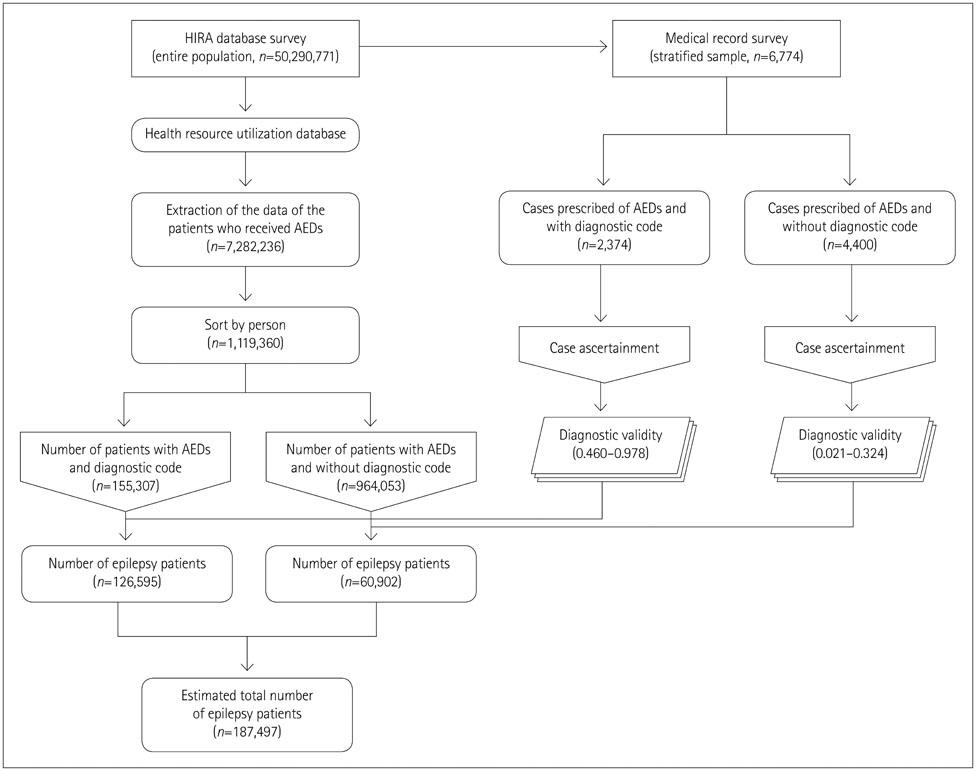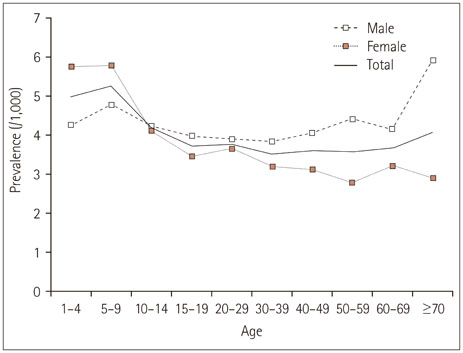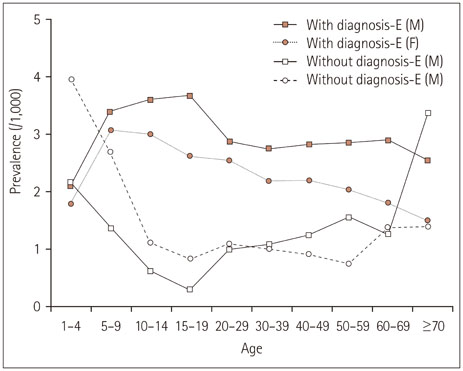J Clin Neurol.
2016 Oct;12(4):434-440. 10.3988/jcn.2016.12.4.434.
Estimating the Prevalence of Treated Epilepsy Using Administrative Health Data and Its Validity: ESSENCE Study
- Affiliations
-
- 1Department of Neurology, Kangwon National University College of Medicine, Chuncheon, Korea.
- 2Department of Social and Preventive Medicine, Sungkyunkwan University School of Medicine, Suwon, Korea. hkcheong@skku.edu
- 3Department of Neurology, Konkuk University, School of Medicine, Seoul, Korea.
- 4Department of Pediatrics, Korea University College of Medicine, Ansan, Korea.
- 5Department of Pediatrics, Yonsei University College of Medicine, Seoul, Korea.
- 6Department of Neurology, Keimyung University School of Medicine, Daegu, Korea.
- 7YiSangDo Neurology Clinic, Daegu, Korea.
- 8Department of Neurology, Seoul National University College of Medicine, Seoul, Korea. jungky@snu.ac.kr
- KMID: 2385107
- DOI: http://doi.org/10.3988/jcn.2016.12.4.434
Abstract
- BACKGROUND AND PURPOSE
Few of the epidemiologic studies of epilepsy have utilized well-validated nationwide databases. We estimated the nationwide prevalence of treated epilepsy based on a comprehensive medical payment database along with diagnostic validation.
METHODS
We collected data on patients prescribed of antiepileptic drugs (AEDs) from the Health Insurance Review and Assessment service, which covers the entire population of Korea. To assess the diagnostic validity, a medical records survey was conducted involving 6,774 patients prescribed AEDs from 43 institutions based on regional clusters and referral levels across the country. The prevalence of treated epilepsy was estimated by projecting the diagnostic validity on the number of patients prescribed AEDs.
RESULTS
The mean positive predictive value (PPV) for epilepsy was 0.810 for those prescribed AEDs with diagnostic codes that indicate epilepsy or seizure (Diagnosis-E), while it was 0.066 for those without Diagnosis-E. The PPV tended to decrease with age in both groups, with lower values seen in females. The prevalence was 3.84 per 1,000, and it was higher among males, children, and the elderly.
CONCLUSIONS
The prevalence of epilepsy in Korea was comparable to that in other East Asian countries. The diagnostic validity of administrative health data varies depending on the method of case ascertainment, age, and sex. The prescriptions of AEDs even without relevant diagnostic codes should be considered as a tracer for epilepsy.
Keyword
MeSH Terms
Figure
Cited by 1 articles
-
Changes in the Diagnostic Efficiency of Thyroid Fine-Needle Aspiration Biopsy during the Era of Increased Thyroid Cancer Screening in Korea
Young Ki Lee, Kyeong Hye Park, Young Duk Song, Taemi Youk, Joo Young Nam, Sun Ok Song, Dong Yeob Shin, Eun Jig Lee
Cancer Res Treat. 2019;51(4):1430-1436. doi: 10.4143/crt.2018.534.
Reference
-
1. Banerjee PN, Filippi D, Allen Hauser W. The descriptive epidemiology of epilepsy-a review. Epilepsy Res. 2009; 85:31–45.
Article2. Lee SY, Jung KY, Lee IK, Yi SD, Cho YW, Kim DW, et al. Prevalence of treated epilepsy in Korea based on national health insurance data. J Korean Med Sci. 2012; 27:285–290.
Article3. Kwon S. Thirty years of national health insurance in South Korea: lessons for achieving universal health care coverage. Health Policy Plan. 2009; 24:63–71.
Article4. Guidelines for epidemiologic studies on epilepsy. Commission on epidemiology and prognosis, international league against epilepsy. Epilepsia. 1993; 34:592–596.5. Kang BS, Cheong HK, Jung KY, Jang SH, Yoo JK, Kim DW, et al. The validity and reliability of characterizing epilepsy based on an external review of medical records. Epidemiol Health. 2013; 35:e2013006.
Article6. Statistics Korea. Population. Daejeon: Statistics Korea;2010. cited 2013 Jan 16. Available from: http://kosis.kr/statisticsList/statisticsList_01List.jsp?vwcd=MT_ZTITLE&parentId=A.7. Hamer HM, Dodel R, Strzelczyk A, Balzer-Geldsetzer M, Reese JP, Schöffski O, et al. Prevalence, utilization, and costs of antiepileptic drugs for epilepsy in Germany--a nationwide population-based study in children and adults. J Neurol. 2012; 259:2376–2384.
Article8. Christensen J, Vestergaard M, Pedersen MG, Pedersen CB, Olsen J, Sidenius P. Incidence and prevalence of epilepsy in Denmark. Epilepsy Res. 2007; 76:60–65.
Article9. Chen CC, Chen LS, Yen MF, Chen HH, Liou HH. Geographic variation in the age- and gender-specific prevalence and incidence of epilepsy: analysis of Taiwanese National Health Insurance-based data. Epilepsia. 2012; 53:283–290.
Article10. Parko K, Thurman DJ. Prevalence of epilepsy and seizures in the Navajo Nation 1998-2002. Epilepsia. 2009; 50:2180–2185.
Article11. Wallace H, Shorvon S, Tallis R. Age-specific incidence and prevalence rates of treated epilepsy in an unselected population of 2,052,922 and age-specific fertility rates of women with epilepsy. Lancet. 1998; 352:1970–1973.
Article12. Reid AY, St Germaine-Smith C, Liu M, Sadiq S, Quan H, Wiebe S, et al. Development and validation of a case definition for epilepsy for use with administrative health data. Epilepsy Res. 2012; 102:173–179.
Article13. Franchi C, Giussani G, Messina P, Montesano M, Romi S, Nobili A, et al. Validation of healthcare administrative data for the diagnosis of epilepsy. J Epidemiol Community Health. 2013; 67:1019–1024.
Article14. Holden EW, Thanh Nguyen H, Grossman E, Robinson S, Nelson LS, Gunter MJ, et al. Estimating prevalence, incidence, and disease-related mortality for patients with epilepsy in managed care organizations. Epilepsia. 2005; 46:311–319.
Article15. Tu K, Wang M, Jaakkimainen RL, Butt D, Ivers NM, Young J, et al. Assessing the validity of using administrative data to identify patients with epilepsy. Epilepsia. 2014; 55:335–343.
Article16. Christensen J, Vestergaard M, Olsen J, Sidenius P. Validation of epilepsy diagnoses in the Danish National Hospital Register. Epilepsy Res. 2007; 75:162–170.
Article17. Pisu M, Kratt P, Faught E, Martin RC, Kim Y, Clements K, et al. Geographic variation of epilepsy for older Americans: how close to the geographic variation of stroke? Epilepsia. 2012; 53:2186–2193.
Article18. Fong GC, Kwan P, Hui AC, Lui CH, Fong JK, Wong V. An epidemiological study of epilepsy in Hong Kong SAR, China. Seizure. 2008; 17:457–464.
Article19. Gu L, Liang B, Chen Q, Long J, Xie J, Wu G, et al. Prevalence of epilepsy in the People's Republic of China: a systematic review. Epilepsy Res. 2013; 105:195–205.
Article20. Tuan NA, Cuong le Q, Allebeck P, Chuc NT, Persson HE, Tomson T. The prevalence of epilepsy in a rural district of Vietnam: a population-based study from the EPIBAVI project. Epilepsia. 2008; 49:1634–1637.
Article21. Hong KS, Bang OY, Kang DW, Yu KH, Bae HJ, Lee JS, et al. Stroke statistics in Korea: part I. Epidemiology and risk factors: a report from the Korean Stroke Society and clinical research center for stroke. J Stroke. 2013; 15:2–20.
Article22. Berg AT, Testa FM, Levy SR. Complete remission in nonsyndromic childhood-onset epilepsy. Ann Neurol. 2011; 70:566–573.
Article23. Yoo JK, Jung KY, Park KW, Lee DH, Lee SK, Lee IK, et al. Familiarity with, understanding of, and attitudes toward epilepsy among people with epilepsy and healthy controls in South Korea. Epilepsy Behav. 2009; 16:260–267.
Article
- Full Text Links
- Actions
-
Cited
- CITED
-
- Close
- Share
- Similar articles
-
- The Economic Burden of Epilepsy in Korea, 2010
- Relationship of Fatigue to Anxiety and Depression in Epilepsy Patients
- Prevalence of Treated Epilepsy in Korea Based on National Health Insurance Data
- The Validity and Reliability of Characterizing Epilepsy Based on an External Review of Medical Records
- Reliability and Validity of the Korean Version of QOLIE-10 in Epilepsy




